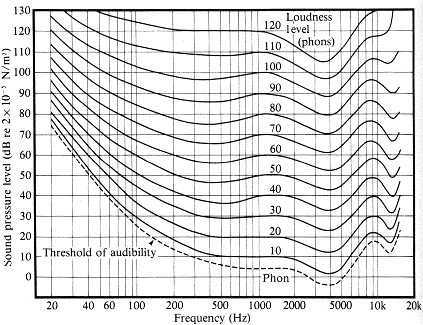Sound II Reading
1. Preception of Sound
1.3. Equal Loudness
The ear is a non-linear device, so does not respond equally across its hearing range. This is what the Fletcher-Munson Equal-Loudness Contours tells us. One of the main characteristics of this is that when a signal is generated at a specific intensity (sound pressure level – SPL), the perceived volume is dependent on the frequency. Our ears are more sensitive to mid-band sounds than low or high frequencies.
Fletcher-Munson Equal Loudness Contours:

What is important understand about this is the level you mix at. This will make a significant difference between having a mix that is balanced correctly versus a mix that has an inaccurate frequency balance. The key is to mix at conversation level. If you have to shout over your mix, you are trying to mix at too loud of a level. Yes, at some point you will need to listen to your mix louder and quieter, but to get the correct balance conversation level is the best. The book states 85 dB as the optimal listening level, but it is really dependent upon the room size. In a small room, 85 dB may be too loud. Attempting to mix at a loud level is one of the fundamental mistake people make when starting out.
The nonlinear frequency response and fatigue over time contribute to further inaccuracies in three ways:
With sounds of long duration and steady loudness level, loudness will be perceived as increasing with the progression of sound until approximately 0.2 seconds of duration. At that time, the gradual fatigue of the ear (and possible shift of attention by the listener) will cause perceived loudness to diminish.
As loudness level of the sound is increased, the ear requires increasing more time between soundings before it can accurately judge the loudness level of a succeeding sound. We are unable to accurately judge the individual loudness levels of a sequence of high-intensity sounds as accurately as we can judge the individual loudness levels of mid- to low-intensity sounds; the inner ear requires time to reestablish a state of normalcy, from which it can accurately track the next sound level.
As a sound of long duration is being sustained, its perceived loudness level will gradually diminish. This is especially true for sound with high sound pressure levels. The ear gradually becomes desensitized to the loudness level. The physical masking (covering) of softer sounds and an inability to accurately judge changes in loudness levels will result from the fatigue. When the listener is hearing under listening fatigue, slight changes of loudness may be judge as being large. Listening fatigue may desensitize the ear's ability to detect new sounds at frequencies with the frequency band where the high sound-pressure level was formally present.